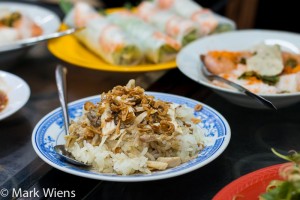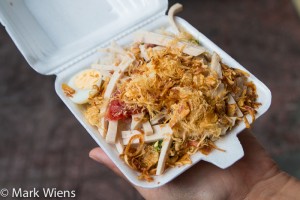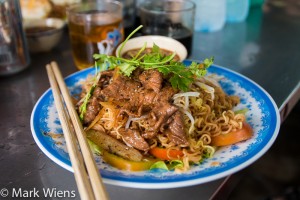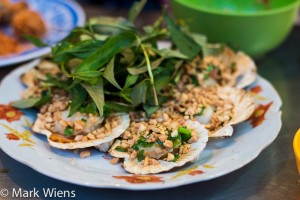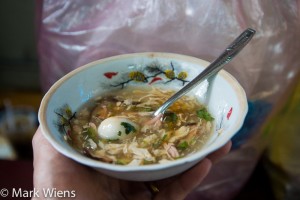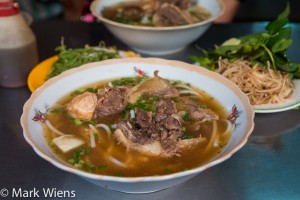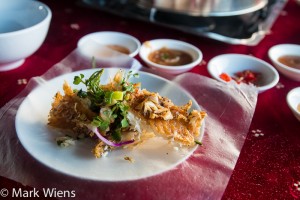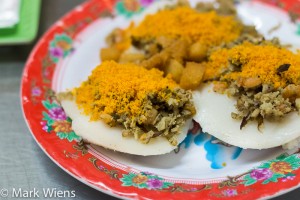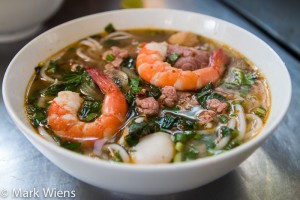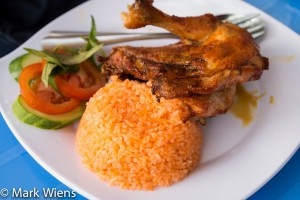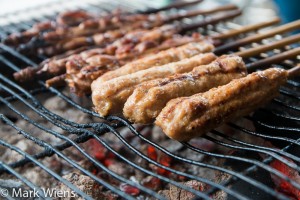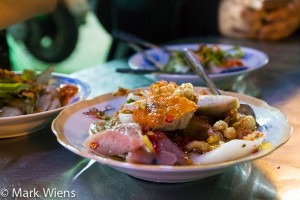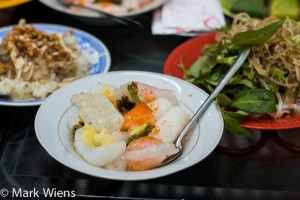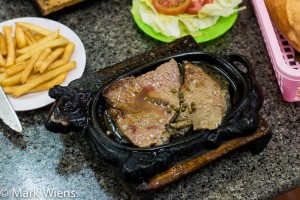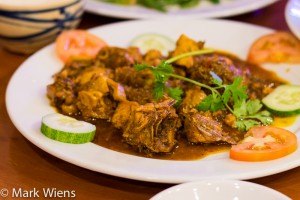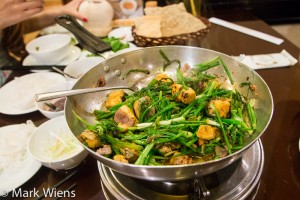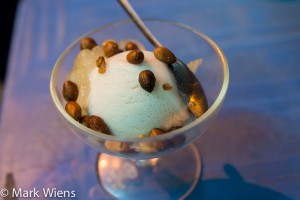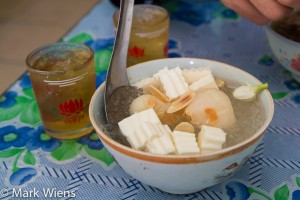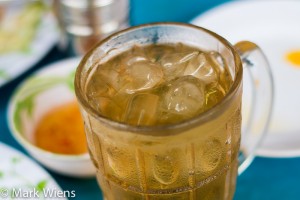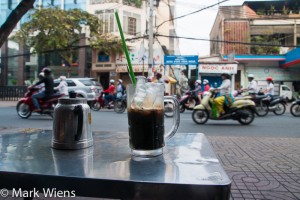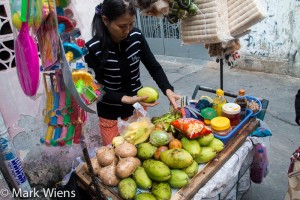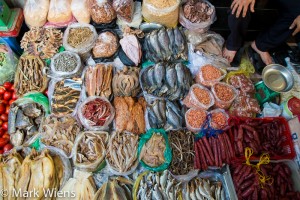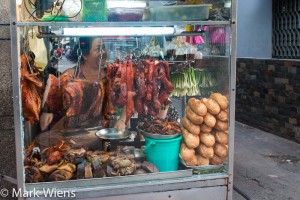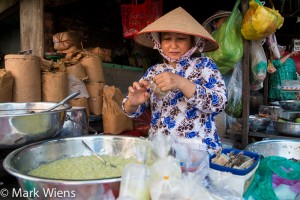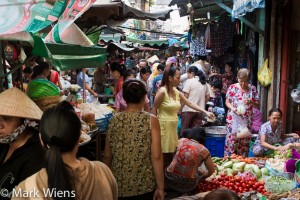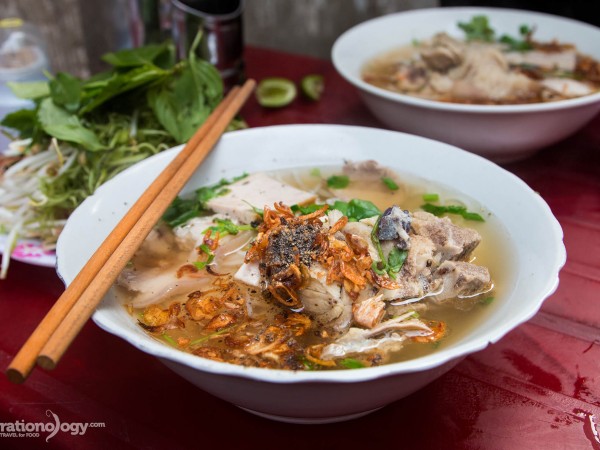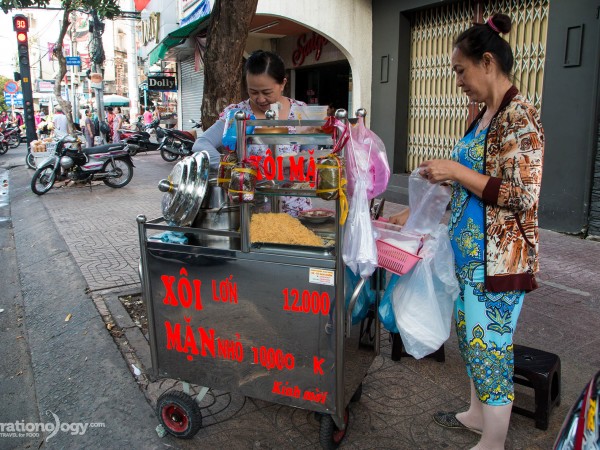
Are you ready to start eating insanely delicious Vietnamese food when you’re in Saigon?
Before going to Saigon, I knew relatively little about Vietnamese food.
So I decided to reach out to you, by posting a video on my YouTube channel, asking what and where I should eat during my trip to Saigon, Vietnam.
I was overwhelmed with the response, and received many local suggestions for everything from restaurants to street food stalls to eat at within the city, and also many favorite dishes to try.
When I landed in Saigon, I had my notes compiled with info on what to eat and where, and I was eager to spend as little time in my hotel as possible, and as much time on the streets eating and enjoying Saigon.
Thank you all for your incredible Vietnamese food suggestions.
It turned out to be one of the most memorable food trips I’ve had in a long time, and my wife and I took photos and videos of almost everything that went into our stomachs.
With this easy guide, I hope you’ll be able to taste, enjoy, and have some incredible food experiences when you’re in Saigon, Vietnam too.
The following guide, featuring 25 Vietnamese dishes to eat in Saigon, is a result of your kind tips and recommendations, kilometers of walking around and sweating, and a month of eating food that I’ll never forget!
Download this post as an eBook (it’s Free)!

Free eBook!: I’ve made this Vietnamese food guide into an eBook that you can download for FREE!
Enter your name and e-mail and I’ll send it to you now:

How to use this food guide:
There are two parts to this guide: the 25 dishes, and the restaurant recommendations.
For the dishes included here, you can really find them all over the place (they are all extremely common), and if you see a sign for one of the dishes, stop at the stall, order it, and try it out.
Also, most of the foods mentioned are single meals or single plate or bowl dishes, not so much the huge feasts, or more expensive Vietnamese speciality dishes.
For the restaurants mentioned in this guide, many are places I was recommended to eat at, others I found from blogs and online articles, and others I just stumbled into while exploring the city.
Please use this guide as a resource and inspiration for what to eat and where, but it’s definitely not the all-inclusive complete guide. There are a countless number of other restaurants and dishes available in Saigon and throughout Vietnam, and I would encourage you to just walk around and explore and try whatever looks delicious.
Hope you enjoy these restaurants in Saigon, I thoroughly did.
Note Again: This is by all means not an exclusive list of Vietnamese foods to try when you’re in Saigon, that would probably fill a library full of books! Rather, this is more a list of dishes I really enjoyed eating and trying during my trip to Saigon, and I think it’s a start, or a beginning, to exploring delicious things to eat in the city.
With all that being said, are you ready to start eating?

1. Bánh mì (banh mi)
If you’re even the slightest bit into Vietnamese food, you’ve probably eaten numerous banh mi sandwiches.
Along with pho, easily the most exported Vietnamese speciality is banh mi. Although banh mi can mean a variety of different things, and in Vietnamese it actually just means bread, sometimes the term can be used to refer to any type of the beautiful Vietnamese personal baguette sandwich.
Walking around Saigon you’ll see dozens of carts with signs selling banh mi – it’s actually hard to go more than a block without seeing one – so it’s never hard to find.
There are many different varieties of banh mi, and here’s a good resource for seeing the different types, but the basic sandwich starts with a crusty baguette that’s sliced in half (sometimes using a scissors) and stuffed with layers of pork, luncheon meats, shredded cured pork skin, pâté, mayonnaise, Vietnamese radish and carrot pickles, a handful of sliced cucumbers, sprigs of coriander (cilantro), and last but not least, an optional, yet in my opinion necessary, scoop of fresh pounded chilies.
The sum of these ingredients together is what really makes banh mi such a glorious sandwich. Coming from Bangkok, where I can’t remember the last time I ate bread or a sandwich for that matter, I was pretty happy to devour as many banh mi as I could when I was in Vietnam.
Here are the three main restaurants I ate banh mi when I was in Saigon.

Bánh Mì Huỳnh Hoa (Banh Mi Huynh Hoa)
Mention banh mi in Saigon, and it won’t be long before someone brings up Bánh Mì Huỳnh Hoa (Banh Mi Huynh Hoa), what is easily the most famous place to eat banh mi pate in the city.
During just about all business hours, Bánh Mì Huỳnh Hoa (Banh Mi Huynh Hoa) remains busy and hectic, and if you go in the evening, you’ll actually need to be on the aggressive side to place your order and get your sandwich.
The banh mi was absolutely stuffed with multiple layers of different luncheon meats, pate, and mayonnaise, but there were less pickles, cucumber, and cilantro than on other versions I ate. So this is really a meat lovers dream come true.
For myself, the sandwich at Bánh Mì Huỳnh Hoa (Banh Mi Huynh Hoa) was actually almost too heavy, and packed with too much fatty meat, but then again, I have to admit it was pretty tasty.
I can sure see why it’s so famous, and if you’re a banh mi lover, this is a place you don’t want to miss.
Address: 26 Lê Thị Riêng, Ben Thanh, District 1, Ho Chi Minh City, Vietnam
Open hours: About 3:30 pm – midnight daily
Price: 30,000 VND ($1.40), more expensive than others, but worth it for the amount of meat
Bánh Mì Hồng Hoa
I was just walking around Saigon one morning when I stumbled into a restaurant called Bánh Mì Hồng Hoa.
I noticed there were quite a few motorbikes rolling up, ordering sandwiches and fresh bread, and some motorbikes loading up big bags of baguettes. That was enough of a sign for me to need to eat there.
I ordered just the standard bánh mì, a fresh and crusty baguette filled with slices of pork, luncheon meat, pate, mayonnaise, some nicely flavorful chillies, and a handful of freshly sliced cucumbers, and fragrant cilantro.
What I especially loved about their version, was that it was heavy on the herbs and fresh veggies.
The family running the business were all very nice and helpful, and they were excited that I was eating there. It turned out to be one of my favorite banh mi sandwiches of my time in Saigon.
Address: 62 Nguyễn Văn Tráng, District 1, Ho Chi Minh City, Vietnam
Open hours: I think open in the morning, I arrived at 8 am, and they seemed to be at their peak serving, so good place for breakfast
Price: 17,000 VND ($0.80)

Banh Mi 37 Nguyen Trai
Another banh mi favorite, located right in the heart of Saigon, and pretty popular with both locals in the neighborhood and tourists, is a stall that sets up in the late afternoon, known as Banh Mi 37 Nguyen Trai.
They specialize in banh mi filled with little grilled minced pork sliders. The pork was seasoned and freshly grilled, and when I ordered, the baguette was filled with grilled pork patties and lots of cucumbers and herbs, and sauce that was almost like teriyaki.
Overall, very good, and if you’re in the area, it’s a definite must-stop to eat snack.
Address: 37 Nguyễn Trãi, Ho Chi Minh City (though the address is 37, it’s right at Hem 39)
Open hours: From around 4:30 pm – 7:30 pm each day
Price: 16,000 VND ($0.75)

2. Ốp la (op la)
A beautiful alternative to the banh mi sandwich is a Vietnamese dish called op la, or eggs cooked in a littler personal pan, often supplemented by slices of meat like ham, onions, and served with those wonderful crusty Vietnamese baguettes.
Just like some other dishes on this blog, op la offers a bit of a fusion of Vietnamese and Western ingredients and cooking methods, all blended into a single meal.
Although there are many variations of op la, to me what really makes it good is if the eggs are sunny side up, so the yolk is extra runny, and what makes it even better is if it’s served topped with caramelized onions and peppers.
Banh mi op la makes a favorite breakfast for many locals in Saigon, and it most definitely hits the spot before a long day exploring the city.

Bánh Mì Hòa Mã
When I was in Saigon, one of the places I was really excited to eat at was Bánh Mì Hòa Mã, which a few of you recommended, saying I needed to try it.
After doing a bit more research, I found out another great blog, Eating Asia had already written about this spot.
It’s a popular breakfast place, and, although they had a few different things on their menu, their main dish is banh mi op la, fresh toasted baguettes with eggs fried in a personal pan.
Just a few moments after I ordered, my flaming hot (you can literally hear the sizzle as it’s brought down the alley to your table) personal pan of fried eggs was rushed to my table, with an aroma that made my taste buds water immediately.
I ordered two runny eggs, which were topped with a handful of assorted fried luncheon meats (they taste similar to SPAM), and a handful of caramelized onions and green peppers.
Along with serving wonderful food, another great thing about eating here is the open air, side of the street dining atmosphere. The kitchen is located on the corner of the main Cao Thang road, but little plastic tables and chairs are set up along the quieter side of the alley, lined up in a row.
Eating a delicious breakfast of banh mi op la, sitting next to the cool shaded wall, could hardly get any better for me.
It was one of the best breakfasts I had.
Address: 53 Cao Thắng, District 3, Ho Chi Minh City
Open hours: 7 am – 10 am or so, until they sell out
Prices: For a full banh mi op la the price is somewhere around 30,000 – 40,000 VND, our total bill for two of us, with two meals, tea, bread, and pate came to 91,000 VND ($4.21)

3. Phở (pho)
No matter if you’ve been to Vietnam before or not, you’ve likely heard of pho, if not already eaten it many times before.
The noodle soup didn’t become so famous for nothing – it really is one of the most common dishes in throughout the country, and it makes the Vietnamese food menu at nearly every sit-down restaurant too.
Pho is the combination of soft rice noodles in a soup broth, normally prepared with either bo (beef) or ga (chicken) – both of which can be extremely delicious, but I’m normally more of a beef kind of guy.
The noodles are flash boiled until soft, topped with your choice of meat, and often finished with a sprinkle of chopped green onions and sometimes sweet onions as well.
But what I really love most about eating pho in Vietnam is the fresh plate of herbs, typically including sawtooth herb, mint, and Vietnamese coriander, along with house-made chili sauce, that’s on your table for self-service when you eat it.
While I did enjoy a bowl of pho from time to time when I was in Vietnam, I think pho is sort of the pad thai of Vietnamese cuisine, in that, yes it’s very good, however there are also so many other delicious dishes to try – perhaps it has a little undeserved fame, when compared to so many other delicious Vietnamese dishes?

Pho So 1 Ha Noi
After visiting the cathedral of Notre Dame and walking around the park for a while, I continued walking along the street, and all of a sudden I felt myself getting extremely hungry.
I looked up, and there was a pleasant looking restaurant called Pho So 1 Ha Noi.
It was a nice open air eatery, with clean metal tables, and stashed piles of herbs and condiments. I ordered pho bo (beef pho ) and Ying had the pho ga (chicken pho), both of which were simple, and flavorful.
I especially loved the all-you-can-eat herbs, pickled garlic, and chilies. The owner, was quite a friendly man as well.
Pho So 1 Ha Noi is a great simple restaurant to eat pho at if you happen to be in the area. After eating here and looking this place up, I found Jodi also loves this place.
Address: 25 Nguyễn Thị Minh Khai, Saigon, Vietnam
Open hours: All day and night – they are open 24 hours
Prices: 28,000 VND ($1.29) for a bowl
Phở Phượng 25
There are countless restaurants in Ho Chi Minh City to devour a bowl of pho, from the tiniest of street food stalls, to indoor air conditioned restaurants.
I think probably the best versions of pho (and possibly the best versions of many dishes throughout southeast Asia), come from the restaurants that are somewhere in-between – the open air, family run establishments – sometimes in shophouses, sometimes in the front of homes, and sometimes at the bottom of apartment buildings.
I was browsing through Vietnam Coracle, when I found Phở Phượng 25, and I was in the area one day, so decided to try it. I ordered the pho tai, the rare beef version of pho.
The broth was a little on the sweet side for me, but it was nicely balanced, just slightly oily, but rich and flavorful, with a subtle hint of spice. The beef, after dipping it in the roasted chili sauce, was delicious.
Address: 25 Hoàng Sa, District 1, Ho Chi Minh City, Vietnam (it’s located very close to the famous Lunch Lady of Saigon)
Open hours: 6 am – 9 pm daily – great for any meal
Prices: 40,000 VND ($1.85) for my bowl
Other suggestions for pho in Saigon I received but wasn’t able to eat at (yet):

4. Bún riêu (bun rieu)
Vietnam is a land of noodle soups, and many enjoy at least one bowl of noodles a day, some, maybe even a few.
After trying many different types of Vietnamese noodle soups during my stay in Saigon, I “think – and I say that because I change my food mind quite often” I can say my favorite is bun rieu.

The broth is made from a crab base stock, and another key ingredient are tomatoes, which create a broth that’s slightly seafood tasting, yet has a beautiful natural sweet and tartness from the tomatoes. I think there’s also often some rice vinegar included in the recipe to give it a lovely sour and well-rounded flavor.
Along with the wonderfully flavorful broth in a bowl of bun rieu, the noodles are often similar in shape and size to spaghetti noodles, except soft rice noodles.
Topping the noodles are pieces of golden fried tofu, sometimes meatballs, hearty chunks of pork, squares of congealed pig’s blood, and finally a slab of rich crab paste.
The dish reminded me of a few similar Thai dishes like northern Thai nam ngiao, a tomato stew.
To eat bun rieu, you normally garnish it with shrimp paste or crab paste, then load it up with chili sauce, a squeeze (or I like multiple squeezes) of lime juice, and then devour it with a small mountain of herbs and shredded vegetables.
For noodle soup in Vietnam, I really think it can’t get much better than a steaming hot bowl of bun rieu cua.
Bún riêu Nguyễn Cảnh Chân
Another recommendation from the YouTube video, was a restaurant called Bún riêu Nguyễn Cảnh Chân.
It proved to be an insanely delicious restaurant, that not only served an excellent bowl of bun rieu cua, but the staff were all friendly, and I like that the restaurant was located on a pleasant wide side road in Saigon, shaded by nice big trees.
My bowl of bun rieu cua at Bún riêu Nguyễn Cảnh Chân was perfectly balanced, with a gorgeous crab flavor, a hint of bitterness, and a light sweetness from the always simmering tomatoes.
The meat and other ingredients in the soup were generously added, and the condiments were pungent and flavorful. This was indeed one of my most memorable bowls of noodles during my trip to Vietnam.
Address: 18/5 Nguyễn Cảnh Chân, District 1, Ho Chi Minh City
Open hours: 11 am – 7 pm daily
Prices: 45,000 VND ($2.08)
Here are some other recommended places:

5. Bún mắm (bun mam)
Graham Holliday, an author and expert on Vietnamese food labels bun mam, despite its pungent smell, as his wholly favorite Vietnamese noodle dish.
Bun mam is specifically a southern Vietnamese dish, and just like most other noodle soups, you’ll find it at both sit down restaurants and portable street food stalls around town – though it’s not nearly as common to spot as some other noodle dishes on this blog.
The base of any bowl of bun mam (bún mắm) is a dark colored broth prepared with fermented fish sauce (which I believe is similar to Thai pla ra).
The fermented fish sauce gives the soup broth a well rounded, balanced flavor, and it’s honestly not nearly as fishy as it might sound or smell.
Along with the broth, bun, or rice vermicelli noodles, are loaded into the bottom of the bowl, before the entire assortment of meats like squid, prawns, and pork are all scattered on top of the noodles.
Finally, a slice or two of eggplant, which soaks up all the broth, is another essential component of a bowl of southern Vietnamese bun mam.
In addition to the glorious fish flavor, the broth of a bowl of bun mam is usually sweetened with tamarind juice and sugar.
Although bun mam was honestly a little too sweet of a flavor for me (I’d go with a bowl of bun rieu most of the time), it is widely popular, and it’s a Vietnamese food you definitely need to try when you’re in the city.
Bún Mắm Phan Bội Châu
Recommended by both from Mark from Sticky Rice Hanoi (one of the top Vietnamese food blogs especially covering Hanoi) and Jodi from Legal Nomads, Bún Mắm Phan Bội Châu is a longstanding restaurant, located right across the street from Benh Thanh Market, that serves hot fresh bowls of bun mam.
Their broth was dark and beautiful, and along with the noodles, the mixture of goodies, like shrimp, a slice of pork belly, and a few bites of tangly squid were wonderful.
Get exclusive updates
Enter your email and I’ll send you the best travel food content.
Probably my favorite bite out of my entire bowl of bun mam, was not even the meat, but it was the eggplant, which was extremely succulent and juicy.
Despite enjoying my bowl of bun mam, I thought their broth was overall much too sweet for my personal preference. I’m not sure if it’s always like this, or if this particular restaurant serves their bun mam on the sweet side?
Nevertheless, Bún Mắm Phan Bội Châu is in a great location, so if you happen to be shopping at Benh Than Market, you can easily stop by to sample it.
Address: 22 Phan Bội Châu, across from Ben Thanh market, Saigon
Open hours: Not sure exactly, but they are open for breakfast, lunch and throughout the afternoon
Price: 65,000 VND ($3) per bowl

6. Bún bò Huế (bun bo Hue)
Probably one of the dishes most mentioned that many of you suggested I should eat in Vietnam was bun bo Hue (I think there’s an entire Vietnamese culture surrounding this dish, and it may be gaining some traction against pho)!
Alright, bun bo Hue is not actually from Saigon, it originates in Hue – a city on the coast of central Vietnam, which unfortunately I haven’t been able to visit yet – but I included it on this Vietnamese street food guide because it’s one of the most beloved noodle soups in Saigon as well.
Bun bo Hue is beef based, and in Vietnam it’s known for being spicy and flavorful.
The broth, which if made to specification, should be full of beef bone flavor, and fragrant with lemongrass, has a wonderful taste, like a citrusy beef soup.
The noodles are normally rice vermicelli noodles, of the sphagetti size, and a bowl of bun bo Hue is often served with slices of beef, a hunk of either ox tail or pork knuckle, cha lua (Vietnamese sausage and ham), and a handful of green and sweet onions.
Again just like every other noodle dish, the extra herbs, flash boiled vegetables, and chilies, give bun bo Hue an added dimension of deliciousness.
i am a food blog calls bun bo Hue, a dish “you never knew you loved,” and that was true for myself, having never had it before going to Vietnam, but I loved it (by the way, check out her amazing recipe for the dish).
For myself, after bun rieu, bun bo Hue is probably my next favorite Vietnamese soup, and I haven’t even been to Hue yet.
Bún bò Chú Há
I’ve eaten noodles for years and years in Asia, and throughout multiple countries, and I have to say, Bún bò Chú Há was the first bowl I’ve ever had served in a clear see-through bowl.
It was pretty cool, like eating out of a fish aquarium where I could see what was swimming in my soup.
All jokes aside, I thought the bun bo Hue at Bún bò Chú Há restaurant was wonderful. The broth had a superb umami depth to it, was salty and just slightly sweet, with a citrus touch.
The slices of beef were lightly chewy, as they should be, but the real highlight was the hunk of ox tail (I think?), which was tender and juicy, and just slid off the bone.
Along with serving a delicious bowl of bun bo Hue (and those awesome transparent glass bowls), the duo of ladies who served me (whom I assume are the owners of the family run restaurant) were extremely kind.
After she dished out my hot bowl of soup, I took about 50 pictures from all angles, and after photographing my bowl, I then sat down to make a video and eat it.
But just as I was about to start seasoning my bowl, the owner ran up to me, and said something and grabbed my bowl. Next she proceeded to dump out all the broth (which was cold by then), and filled it up with brand new hot steaming broth.
She handed it back to me with a smile. Now that’s Vietnamese hospitality.
Address: 300 Võ Văn Tần, District 3, Ho Chi Minh City
Open hours: 6 am – 10 pm daily
Price: 60,000 VND ($2.77) per bowl, a bit expensive, but extremely generous on the meat
Also check out these spots:

7. Bún mọc (bun moc)
On one of my final days in Saigon, I was walking around a local neighborhood market and decided to try yet another Vietnamese noodle soup dish – this time, a dish called bun moc.
The noodles, bun, are the thin soft rice vermicelli noodles, which are so easy to eat and go down so easily as well.
The broth in bun moc is normally pork based, a simple and soothing soup, that’s not spicy at all, but just comforting. It’s the type of noodle soup you might want to eat relaxing rainy day.
Along with the rice vermicelli noodles and pork broth, a bowl of bun moc also typically includes some chunks of pork meat, maybe even a bone, meatballs, and Vietnamese sausage.
Although bun moc is said to have originated in the north of Vietnam, it’s extremely popular throughout Saigon as well.
Bun moc street food stalls
Since I had so many other Vietnamese foods to try, I actually only managed to eat bun muc once, at a small tiny little street food stall in the middle of an alley near Chợ Bàn Cờ market (I put the little food stall on the map, but this place is not worth going out of your way just to eat, because you’ll find the same thing all over the city).
The lady serving the bun moc was extremely friendly and generous, and I ordered up just her normal bowl of bun moc.
The noodles were slippery and silky, and my bowl included a nice hunk of pork, some slices of Vietnamese sausage, and what really made it for me, a handful of crispy deep fried shallots thrown on top.
I seasoned my bowl of bun moc with lime juice, plenty of black pepper, herbs, and crushed chilies, and it was a wonderful Vietnamese street food breakfast.
Price: 30,000 VND ($1.38)

8. Hủ tiếu Nam Vang (Hu tieu Nam Vang)
Yet another dish, that has a huge following of Vietnamese cuisine lovers, is Hu tieu Nam Vang.
Nam Vang, as I understand, is the Vietnamese word for Phnom Penh in Cambodia, and Hủ Tieu has connections to Teochew in China.
So what does that have to do with this Vietnamese favorite food?
As I’ve read, Hủ Tieu Nam Vang is a Cambodian and Chinese pork based noodle soup, that contains slices of all sorts of organs, and a shrimp or few, plus an assortment of other additions.
Hủ Tieu Nam Vang was a little on the plain side for my personal taste buds, but I did like it when spiced up with some chili paste, loaded with chilies, and combined with that huge fresh plate of herbs and vegetables that it’s always served with.
I often saw local Vietnamese season their Hủ Tieu Nam Vang with the transparent looking chili sauce and dark soy sauce as well.
Hu Tieu Nam Vang on the street
Just a few minutes walk from where I was staying at Le Blanc Hotel in Saigon was Cao Thang road (where there are a number of wonderful restaurants including the outstanding op la restaurant #2 on this food guide), I was walking around when I noticed a crowd huddled around a noodle stall on the street.
Dangling from a tree branch was a sign that said “Hủ Tiếu Nam Vang – 22,000” – and the price and the atmosphere made it nearly impossible for me not to sit down for a bowl.
Since it was quite a budget price for a bowl of noodles especially in central Saigon District 1, it wasn’t all that heavy on the meat, yet it was a nice mixture of noodles, pig parts, a shrimp, and a nice basket of herbs and vegetables to garnish.
It was simple, but just normal, and quite tasty, plus the street food atmosphere here was perfect.
Address: It’s on Cao Thang road just past Nguyen Dinh Chieu
Open hours: Open for lunch for sure from about 10 am – 2 pm or so
Price: 22,000 VND ($1) – it’s pretty cheap but didn’t include much meat

Hủ tiếu Nam Vang Nhân Quán
Another bowl of Hủ tiếu, this time a different style, was at another restaurant not far from where I stayed, at a famous place called Hủ tiếu Nam Vang Nhân Quán.
The bowl of noodles at this restaurant was more expensive than at the street food stall above, but it included at least twice the amount of meat, and it indeed was better quality.
This time around, I ordered yellow egg noodles and instead of the soup inside, I got the soup on the side. I have to admit, this was a marvelous bowl of noodles, stacked with toppings and flavor.
Address: I think there are a number of different location, but I ate at the branch on 72 Nguyễn Thượng Hiền
Open hours: About 5 pm – 10 pm
Price: 65,000 VND ($3)
Other suggestions which I haven’t tried:

9. Bún chả (bun cha)
Just like bun bo Hue, another dish on this list that’s not from Saigon, but this time rather from Hanoi, is bun cha.
The reason I included it on this Saigon food article is because I simply love it – if there’s ever a restaurant with a country wide Vietnamese food menu, I would probably jump at bun cha.
When I visited Hanoi, years ago back in 2010 or so, I had bun cha at one of the most well known spots, and it blew my mind with how good it was.
For years I dreamed about another bowl of bun cha, until finally I returned to Vietnam this time-round, and I needed to satisfy my craving.
Bun cha is a dish that uses bun, fresh rice vermicelli noodles, the same noodles used in bun thit nuong, which are soft and easy to chew.
The next component of bun cha, are little seasoned pork patties (kind of like pork sliders), that are grilled over charcoal.
A plate of bun is served alongside a bowl of grilled pork patties, which after being grilled, are served in a smokey sour soup, and finally a plate of herbs and green vegetables are served to accompany everything.
The main way I saw most Vietnamese eating bun cha, was to add a bit of rice vermicelli to the pork patty soup, garnish with garlic, chilies, and herbs, and then repeat.
Bun cha is an absolute sensational dish, and if you don’t visit Hanoi, even though that’s definitely where the best is, you can still try it in Saigon.
Bún Chả Ánh Hồng Hà Nội
From some research on many Vietnamese food blogs and websites, on one of my final days in Saigon, I finally decided to try and get a flavor for the dish I had missed for so long since my previous trip to Hanoi.
I settled on a place called Bún Chả Ánh Hồng, because it wasn’t too far, and I had tried to visit a few places closer to Benh Thanh Market that seemed to be closed.
Anyway, when I arrived to Ánh Hồng, I could smell the aroma of pork smoke pouring from the entrance. From the front it looked just like a tiny restaurant, but walk into the alley, and inside the restaurant opens up into a large courtyard with plenty of tables and staff.
The grilled pork was wonderful, extremely smoky, and the soup was salty and a little sweet. The bun and herbs were delicious.
Overall, it wasn’t as good as I remember in Hanoi, but it was still pretty tasty and definitely worth eating.
Address: 140b Lý Chính Thắng, District 3, Ho Chi Minh City, Vietnam
Open hours: 6:30 am – 8 pm daily
Prices: bowls of normal sized bun cha combinations are 38,000 VND ($1.75)

10. Bánh canh cua (banh canh cua)
Banh canh, according to Wikipedia, actually means soup cake in Vietnamese, that’s the literal translation.
That’s likely because the noodles are so hearty and so thick.
Banh canh is quite similar to Japanese udon noodles, except I thought the noodles, which are typically made with a combination of rice and tapioca starch, were more sticky and a little chewier than udon, which are typically made with wheat flour.
Although there are a few different versions of banh canh, the one I ate, and fully enjoyed was banh canh cua, the thick starchy noodles with crab.
Instead of being a typical noodle soup with a thin stock, banh canh cua is more like a hearty stew, the broth is thickened like gravy, almost like Thai cuisine style radna.
The gravy normally has quite a mellow crab flavor, but what’s really impressive are the nuggets of crab meat that come in a bowl, and the toppings, including chilies and limes.
If you’re a crab lover like I am, this is a Vietnamese dish for you.

Bánh Canh Cua Trần Khắc Chân
A few of you said that this was your favorite version of banh canh cua in all of Saigon, so I knew it was a place I needed to try.
Trần Khắc Chân only opens in the afternoon, and I thought I was going to beat the crowds by arriving at a random time, about 3 pm in the middle of the afternoon. But I arrived to find nearly the entire restaurant was already packed out.
I ordered just the normal bowl of banh canh cua, which was pretty good sized, and came brimming to the top of the bowl with gravy, swirls of noodles, and an impressive collection of crab and meatballs. A hit of lime juice and chilies made things even better, and I absolutely loved it.
On top of a marvelous bowl of banh canh cua, all the staff and the owner of the restaurant were all very kind and smiled when we said we were from Thailand.
Address:87 Trần Khắc Chân, Ho Chi Minh City
Open hours: 2 pm – 9:30 pm daily
Prices: 35,000 VND ($1.62) per bowl, and then I had a plate of Chinese donuts for just – 3,000 VND, good price for great food

11. Bún thịt nướng (bun thit nuong)
Vietnamese cuisine is brilliant for combining a contrast of flavors and textures into a single dish, and I think bun thit nuong, or better yet bun thit nuong cha gio, is a great example of this.
The dish normally begins with a handful of chopped up herbs and lettuce at the bottom of a bowl, then in goes fresh rice vermicelli noodles (similar to Thai khanom jeen noodles), then a few skewers of grilled pork are layered on that, and finally a sweet and salty fish sauce, and a scoop of oily chives and green onions, and pickles are all added on top.
If you get the bun thit nuong cha gio, in addition to everything already mentioned, you’ll also get a fried spring or two chopped up on top, which bumps the delicious-meter up another notch.
The noodles are soft and silky, the pork is tender, salty, and sweet, and the egg rolls (cha gio) add a beautiful crunch to everything.
When I was in Vietnam, I enjoyed dousing my bowl of bun thit nuong with a few scoops of freshly ground chili (which should usually be on your table) to balance out the sweetness and make it fiery.
Bun thit nuong is a dish you should for sure not miss when you’re eating in Saigon.
Chị Thông Bún Thịt Nướng
Chị Thông is a well known spot in Saigon for bun thit nuong. I was originally tipped for this spot from Eating Saigon, a great food blog if you’re looking for delicious restaurants to eat at in Saigon.
They open starting in the morning and don’t close until the night, so you can go to get your fix of this famous dish pretty much anytime you’re craving it. I decided to go for a mid-morning breakfast – I think we arrived at about 9 am. There were just a few other diners, so it wasn’t too busy, but they still had plenty of fresh food.
I ate bun thit nuong cha gio, including rice vermicelli noodles, some shredded herbs and lettuce, and then on top, a couple of grilled skewers of pork, plus a chopped fried spring roll (cha gio). Finally, a scoop of sauce, a spoon of Vietnamese pickles, and a garnish of green onions and pork rinds, to top it off.
The bun thit nuong at Chị Thông was very tasty, good quality, and it’s a nice clean restaurant.
In addition to delicious food, everyone there was so friendly – when I was taking photos and a video, they were incredibly nice to me.
Address: 195 Cô Giang, District 1, Ho Chi Minh City
Open hours: 7 am – 10 pm daily
Prices: 40,000 VND ($1.85)

12. Bánh tằm bì (banh tam bi)
Bánh tằm bì is a food that’s only available in the south of Vietnam, and if you love the flavor of coconut milk, you’re going to fully enjoy banh tam bi.
Just like banh canh cua (food featured above), banh tam bi is a dish that uses a similar thick noodle – yet the flavor and the toppings are much different.
A plate of banh tam bi often begins with a handful of roughly cut herbs, including lots of sweet basil and Vietnamese coriander on the bottom, topped by a pile of thick sticky rice noodles, a scoop of both finely shaved pig skin and pork meat, a garnish of green onions, and finally a ladle of thick coconut cream sauce.
The noodles are sticky and soft, the herbs add a nice fresh touch, and the gravy is typically sweet and buttery from the coconut milk.
While I did think banh tam bi was pretty good, it’s not a dish I really loved because it was on the sweet side for me, and lacking a strong or spicy flavor.
Nevertheless, it was very enjoyable and I did like it, but it would be more of an occasional dish on my Vietnamese menu repertoire. But again, if you love coconut milk, you should by all means try banh tam bi.
Bánh Tằm Bì Đồng Tháp
Bánh Tằm Bì Đồng Tháp was a restaurant I was recommended to try, and after exploring Chinatown in the morning, we weren’t too far from the restaurant, so we checked it out.
From the outside, I could see the noodles in the display cabinet, and again, they looked almost like Japanese udon noodles.
The little shop was homely and small. At the front were a few display cabinet street food carts, serving both banh tam bi and some Vietnamese desserts (which I didn’t try but looked quite popular). Behind the street food carts was a full dining room with little stainless steel tables and chairs.
I ordered just the normal plate of banh tam bi, with was assembled by one of the kind ladies there.
It was rich and creamy, and although as I mentioned already, it was a little sweet for me, I did really like the mix of fresh Vietnamese herbs, and the rich coconut milk.
They also serve a number of other dishes like cha gio (fried spring rolls) and banh mi (sandwich).
Address: 352 Nguyễn Trãi, District 5, Ho Chi Minh City, Vietnam
Open hours: 9 am – 11 pm daily
Prices: All together we ate 2 plates of banh tam bi, 1 banh mi, 1 plate of goi cuon (fresh summer rolls), plus a couple of drinks, and our total price came to 126,000 VND ($5.86) – so I’m guessing the plates of banh tam bi were about 30 – 35,000 VND each

13. Bánh cuốn (banh cuon)
I’m a huge fan of Vietnamese bánh cuốn, and though originally comes from the northern part of the country, it’s extremely popular throughout Saigon.
Banh cuon, which directly translates to rice cakes, are sort of like noodle wrapped, non-deep fried spring rolls, packed full of savory ingredients.
To prepare the recipe for banh cuon, a thin layer of rice and tapioca flour batter is steamed into a noodle like crepe. It’s then filled, often with a combination of lightly seasoned minced pork, small dried shrimp, and wood-ear mushrooms, and served with finely shaved lettuce and blanched bean sprouts on the side.
Finally, you can’t eat banh cuon without dipping it into sweet fish sauce, known as nuoc cham, the stuff many people say is the lifestream of Vietnamese cuisine, and I personally can’t live without chilies.
What I love about banh cuon are the soft fresh noodle wrappers, and since I’m not a huge desserts or sweets lover, I like the salty mix of pork and shrimp on the inside.
When I was walking though local fresh wet markets in Saigon, I noticed banh cuon being made all over the place, especially in small tightly packed alleys. So keep an eye out for banh cuon all over the place.
Bánh Cuốn Hải Nam

One of the most well known restaurants to eat banh cuon in Saigon is Banh Cuon Hai Nam.
The restaurant is not hard to miss, with its huge big blue sign and red popping characters, and at night, the sign lights up with near obnoxious flashing lights, and a host of pink shirted waitresses and cooks.
On the front patio of Banh Cuon Hai Nam you can watch the the rice batter crepes being steamed, and then freshly assembled into the delicious rolls.
They actually have a full menu of different Vietnamese noodle dishes you can order, but the main and most popular dish is their banh cuon. I also tried their version of banh beo, little bowl sized cakes topped with the same filling as the banh cuon, which were also very tasty as well.
On my first visit to Banh Cuon Hai Nam, I came along with KyleLe.net, who said it was one of his favorite spots in Saigon for banh cuon.
Address: 11A Cao Thắng, District 3, Ho Chi Minh City, Vietnam
Open hours: 7:30 am – 10:45 pm daily
Price: A normal plate of banh cuon is 30,000 VND ($1.38) here

14. Bánh xèo (banh xeo)
Sort of like a crepe, and sort of like a Thai oyster omelet, a Vietnamese banh xeo is a crispy savory snack that’s a favorite for many.
Just like banh mi sandwiches, banh xeo is a bit of a French inspired Vietnamese culture creation.
A thin layer of batter is fried in a lot of oil, then combined with your choice of ingredients, often including slices of pork belly, shrimp, and onions, then folded over with a handful of lightly cooked bean sprouts in the middle.
By far the best part of eating banh xeo for myself is getting to dress and garnish each bite with a bounty of herbs and toppings (are you seeing the pattern with herbs and vegetables in Vietnamese cuisine!?).
You can really eat banh xeo however you want, but the common method is to take a few leaves of lettuce or mustard leaves, load in a piece of the golden crispy crepe, top it with some more herbs like sweet basil and perilla leaves, add some chili (or a lot of it), roll it up like a green spring roll, and then dip the entire treat into the sweet Vietnamese fish sauce dressing.
From what I understand, banh xeo in the south of Vietnam are usually larger in size, almost approaching south Indian dosa status, while in other parts of Vietnam they are usually smaller.
Banh Xeo 46A

Undoubtedly the most well known restaurant in all of Saigon for devouring hot and huge banh xeo is Banh Xeo 46A, and just like the famous Lunch Lady, Anthony Bourdain ate here and made it extremely famous.
Their menu is written in Vietnamese, English, and Japanese, and they might even have a few other languages as well – so you can tell how well known they are – they’ve been included in just about every Vietnam travel guide and food guide.
Today Banh Xeo 46A remains one of the most popular spots in Saigon for the dish. It’s a nice open air restaurant, tucked down a side street. The cooking is all done in the front of the restaurant, and you can see your crepe being prepared right in front of you – and they still use charcoal.
Ying and I ate here with Kyle, and we ordered the special sized banh xeo, a huge crepe filled with shrimp and pork belly. The herbs and vegetables were my favorite part of eating banh xeo.
Address: 46 Đinh Công Tráng, Tan Dinh, District 1, Ho Chi Minh City
Open hours: 9 am – 9 pm daily
Prices: We ordered the giant special banh xeo which was pretty big and pretty expensive at 110,000 VND ($5.09) – prices are very high here due to fame I think
- I also tried the banh xeo at a more upscale restaurant called Banh Khot Co Ba Vung Tau – it was alright, nothing too spectacular
- Also you might try Bánh Xèo Ăn Là Ghiền

15. Bánh khọt (banh khot)
While banh xeo is the crepe of Vietnamese cuisine, banh khot are the little pancake sliders.
I have to say that for myself personally, I enjoy eating banh khot probably better overall than banh xeo – banh khot makes a delicious little light meal or snack.
The batter of banh khot is made from rice flour, sometimes even leftover rice like in Helen’s recipe, coconut milk, and a hint of turmeric powder to give it that slightly yellow color.
The batter is then fried in a hot griddle, the same pan used to make Thai khanom krok (little coconut griddle cakes).
As the batter is sizzling away in plenty of oil, a shrimp is placed in the center of the griddle pancake along with a sprinkle of green onions, which cooks into the top of the batter. The banh khot is finished when the batter is cooked, and the outside is golden and crispy.
Banh khot, just like banh xeo, is served with a healthy assortment of lettuce and mustard leaves, and herbs and green leafy vegetables.
Finally, banh khot wouldn’t be complete without the sweet fish sauce dressing.
Chợ Bàn Cờ market stall
Banh khot is an excellent Vietnamese street food, and as I was walking around local markets in Saigon, I noticed banh khot being made in a number of different places, always quite popular, and at nearly every stall there were people waiting to order.
While exploring Chợ Bàn Cờ market one morning, I stopped at a banh khot stall (which I’m not sure of the name, but I did include it on the map).
She quickly made her banh khot, pouring in the batter, and the smell and sizzle could be detected from across the market.
One of the things I loved about the banh khot here is that after I ordered a plate, she asked if I wanted some extra coconut cream on top. I got half of them with coconut cream, but after tasting it, I wish I would have gotten all of them topped with it.
Anyway, they were freshly fried, still hot and extremely crispy, and one of the best things was the amazing market environment (watch the video if you haven’t already).
Address: Somewhere in the tangle of Chợ Bàn Cờ market
Open hours: No sure, but I think for most of the day
Price: 20,000 VND ($0.92) for a plate that included about 10
Bánh Khọt Cô Ba Vũng Tàu
When I ate at Co Ba Vung Tau, a nicer end restaurant, I had no clue it was famous for banh khot. But by a random chance I happen to order banh khot, among a few other dishes.
Overall the food was good, the service was friendly, and it is a very popular restaurant with local Vietnamese.
I thought the banh khot at the street food stall topped with coconut cream was overall more my style, but Bánh Khọt Cô Ba Vũng Tàu is a nice clean restaurant to eat banh khot.
Their menu also includes all sorts of other dishes, and Vietnamese desserts.
Address: 102 Cao Thắng, District 3, Ho Chi Minh City (but there are a couple of locations)
Open hours: 7 am – 10 pm, if you go during peak mealtimes it can get pretty busy
Price: Ying and I had a full meal of about 3 – 4 dishes for around the 200 – 300,000 VND ($9.23 – $13.85) range

16. Bột chiên (bot chien)
In Singapore and Malaysia it’s known as a carrot cake, in Thailand it’s kkanom pak gat, and in Vietnam it’s known as bot chien. But all versions have Chinese Teochew chai tao kway to thank.
Bot chien is basically fried rice cakes. The rice cakes are made from rice flour and tapioca starch, and although Chinese and some other southeast Asian versions include daikon radish in the cakes, I think they are normally just rice in Vietnam.
The cakes are sliced into bite sized pieces, then fried, normally on a hot skillet in lots of lard, along with some light seasonings, until crispy and golden brown on the edges. Once cooked, the rice cakes are topped with an egg and a handful of green onions before being served.
The result of bot chien are little bite sized nuggets of crispy sticky rice flour, enriched with egg, and with a nice smoky flavor.
It’s not the healthiest Vietnamese delicacy, that’s for sure, but it sure is tasty once in a while.

Street food stall at Chợ Bàn Cờ market
Again, just like some other dishes on this guide, for bot chien I headed to Chợ Bàn Cờ market, mostly because it was near where I was staying, and it’s a wonderful local market (but there are many other similar markets scattered in abundance throughout the city).
Within a lane, there was a table set up, surrounded by motorbikes, like so many other street food dining establishments in Saigon, and as I approached I could smell the sizzling rice cakes.
The bot chien was served on a plate, along with a side sauce which I think was a mostly soy sauce and vinegar that had a sweet tinge to it.
What I really liked about this version of bot chien was that she served it topped with a handful of thinly shredded green papaya, giving it a nice fresh touch.
Address: Somewhere around Hem 174 Nguyễn Thiện Thuật, just off Ban Co street
Open hours: I’m actually not sure, but I ate this plate of bot chien at about 10 am and she was open. I think she’s open from morning to evening.
Prices: 25,000 VND ($1.15) for a plate
For a more sit down bot chien experience, check out Bột Chiên Đạt Thành.

17. Gỏi cuốn & chả giò
While pho might be the first dish that many people think of when they think about Vietnamese cuisine, for myself, it was and always has been goi cuon, the fresh, non-deep-fried summer rolls (though I often call them fresh spring rolls) that are ubiquitous is Vietnam.
Goi cuon are made with rice paper, known as banh trang, that’s slightly moistened, then filled with, typically a mixture of rice vermicelli noodles, pieces of pork, shrimp, and then stuffed with leaves and herbs like basil and lettuce before being wrapped.
Finally, Vietnamese summer rolls are often served with a nutty hoisin dipping sauce and accompanied by freshly ground chili.
I could probably eat goi cuon all day long and with every meal, so I was pretty happy to see them available nearly everywhere I looked in Saigon. From street food stalls to fancy restaurants, you’ll never be far from goi cuon.
Cha gio, are completely different taste-wise than their goi cuon counterparts, and they share few characteristics other than their egg roll shape and the fact that they’re often sold side by side at many restaurants and street food stalls.
Cha gio are Vietnamese deep fried spring rolls, and though I’ve tried spring rolls (or egg rolls) in many places around the world, Vietnam makes some of the best I’ve ever had.
The egg rolls are often a combination of mung bean noodles, minced pork, and sometimes crab if you can find them, mixed with a subtle blend of salty spices, wrapped in rice paper, and then deep fried to a crisp.
What I love most about cha gio is the wrapper, which is typically prepared with rice paper, that when deep fried, almost has the crunch and thinness of baklava.

Where to eat them
Literally, you’ll find both goi cuon and cha gio at all sorts of dining establishments, from street food stalls to fancy restaurants, they are served all over the place.
When I was food exploring in Saigon, my favorite place to eat goi cuon and cha gio was deep within local fresh markets, tucked into alleys, and all of a sudden I’d see a lady rolling up fresh summer rolls and I could hardly resist sitting down for a snack.

18. Bánh tráng trộn (banh trang tron)
I received a number of recommendations to eat a Vietnamese snack called banh trang tron, which as you might remember from above, banh trang is the thin rice paper.
Banh trang tron is a relatively recent Vietnamese creation, a snack of shredded rice paper, seasoned with a chili sauce, and filled with herbs like Vietnamese coriander and basil and supplemented with pieces of squid, salty fish, and quail eggs. There are probably about ten more ingredients I’m forgetting to mention in the mix as well.
It’s basically a snack or junk food, and when I was in Saigon, I noticed that it’s especially popular with youth and the younger generation, and often available at parks and public places, and nearly always served in a plastic bag.
I’m not a huge snacker, I prefer to eat big meals and not indulge in little snacks, but when in Saigon, there’s no choice but to try banh trang tron – it seems the entire younger generation LOVES it.
Bánh Tráng Trộn Chú Viên

For my first taste of banh trang tron, I stopped at Bánh Tráng Trộn Chú Viên and I actually ordered, what seemed to me like the carb-less version of banh trang trong (maybe it was even just mango salad? do you know?), including all the ingredients without the rice paper.
But anyway, though I made a mistake ordering, they for sure have banh trang trong available as well.
Starting around 3 pm, this famous stall opens up along the busy side of the street, and motorbikes pull up to make their snack orders – it’s sort of like an extremely busy drive-through, everyone hungry for banh trang tron.
Address: 38 Nguyễn Thượng Hiền, District 3, Ho Chi Minh City, Ho Chi Minh City, Vietnam
Open hours: 3 pm – 9 pm daily
Prices: 20,000 VND ($0.92)
Notre Dame Cathedral and Turtle Lake at night
Another one of the most popular places to eat banh trang tron in Saigon is outside both the Notre Dame Cathedral and Turtle Lake at night. It’s a huge social hangout area for young people, and there’s nothing better to do when socializing than eat some snacks.
Banh trang tron is served all over the place here, mostly from makeshift street food stands and popup stalls. Sitting around the dark Turtle Lake at night munching on bites of bah trang tron from a plastic bag, was quite enjoyable.
Another similar park snack in Saigon is banh trang nuong, sometimes referred to as a Vietnamese pizza.
A sheet of rice paper is thrown over a grill, topped with a quail egg, some green onions, and occasional other ingredients, then folded over into a crispy taco.
It’s smoky and crunchy, and makes a good Vietnamese leisure snack, and it’s also widely available across these two social hangout spots.

19. Cơm tấm sườn nướng (com tam suon)
You’ve seen all the previous noodle dishes mentioned in this guide, but as much as I love noodles, I love rice more.
So let’s move onto a few of the famous and most beloved Vietnamese rice based dishes.
One of the most common meals I noticed throughout my stay in Saigon, especially known as a southern favorite, is the combination of rice (which is often broken rice, which are partially broken grains of rice that occur in the milling process), topped with a grilled pork chop.
The most basic version is known as cơm tấm sườn nướng, the broken rice and a thin grilled pork chop, served on a plate and accompanied by fish sauce dressing, cucumber pickles, green onion oil, and chilies to garnish.
Starting from the most basic version of com tam suon nuong, you can then upgrade with all sorts of marvelous extra things like a fried egg, Vietnamese meatloaf, pig skin, extra pork, more sausage… the list goes on.
Com tam suon nuong is available all over in Saigon, especially at small street food stalls and markets throughout the city.
I loved eating it for lunch and dinner, and a few times for breakfast as well.
Cơm Tấm Ba Ghiền

Cơm Tấm Ba Ghiền is likely the most famous place to eat Vietnamese broken rice and grilled pork in all of Saigon.
So this was a restaurant I knew I couldn’t miss.
I could literally smell the food from the front of the street as I approached the restaurant – a sweet porky smoky aroma that immediately made my taste buds begin to water.
When I arrived to Cơm Tấm Ba Ghiền they were grilling up a mind-blowing quantity of pork, literally buckets of marinated meat, and two huge grills were continuously churning out delicious thick cut pork chops for the dozens of hungry customers.
I decided to order the full carnivore platter, what I called the grand-slam of Vietnamese food, known as cơm tấm bì chả sườn trứng ốp la, which is literally a little bit of all things meat, plus an egg, all over a small bed of piping hot broken rice.
The pork chop was meaty, sweet and salty, and thickly cut.
The meat loaf and other assorted meats were also wonderful, combining to create what was easily the best version of com tam suon I had during my stay in Saigon.
I have to admit, the food at Cơm Tấm Ba Ghiền was a little on the greasy side, but it was so worth it, and such a hearty plate of delicious protein.
Thank you all for the recommendations to eat here.
Address: 84 Đặng Văn Ngữ, P. 10, Quận Phú Nhuận, Ho Chi Minh City
Open hours: 6 am – 10 pm daily, but I’d say it’s best as a lunch spot, but dinner or breakfast would also be wonderful
Prices: We ordered 1 combination plate, 1 regular plate of rice with just a pork chop, and a couple of drinks and our total bill came to 104,000 VND (I think my combination plate was about 60,000 VND – $2.77, but I think just rice and pork was more about 30,000 VND)
Other Com Tam Stalls
If you catch a whiff of pork grilling on the side of the street, they are most likely serving com tam suon nuong – you’ll find it literally everywhere.
Com tam suon is probably the meal I ate most frequently when I was in Saigon, readily available, more filling, in my opinion, than a bowl of noodles, and I’m a huge rice lover.
At many street side stalls in Saigon a plate of com tam suon nuong, with just the broken rice and pork chop should run around 30,000 VND and with an egg around 35,000 VD – 40,000 VND.
Other place to try:
- Cơm Tấm Hoàng Gia – This place looks good and is highly rated (thanks to … for the suggestion)

20. Cơm bình dân (com binh dan)
Perhaps as readily available as com tom suon around Saigon, is another one of the most typical rice meals you can eat, com binh dan, which literally translates to commoner’s rice.
It’s basically the khao gaeng (rice and curry in Thailand) or nasi campur (rice and curry of Malaysia), style dining experience of Vietnam.
Com binh dan is one of the most filling meals you can buy in Saigon on a budget – easily the best stomach filling meal for value.
At any com binh dan stall you’ll first see a glass cabinet filled with the day’s supply of pre-cooked dishes, all waiting to be ordered.
The food usually ranges from braised pork belly, any number of fish dishes, and one of my favorites, tofu stuffed with minced pork and covered in tomato sauce (if you see it, you’ve got to try it, I’m sill dreaming about it).
To order your meal at a com binh dan street food stall, you can simply point and choose to whatever dishes look good.
Often a plate of rice with 2 or 3 dishes on top will cost 20,000 – 30,000 VND ($0.92 – $1.38), and if you get rice with dishes on the side in separate bowls, it will run a little higher, but you usually get bigger portions.
For myself, being a lover of rice accompanied by multiple meat and vegetable sides dishes, com binh dan is one of my favorite Vietnamese meals to eat for lunch in Saigon.
Com Binh Dan on the street

Walking around one day, I headed down a side street and was greeted by a delicious looking supply of pre-made dishes filled into a glass cabinet, and since I was quite hungry right then, I stopped for lunch.
This restaurant was very typical, so really you’ll find this exact type of food at thousands of stalls throughout Vietnam.
The family serving the food were all very nice and the ladies dishing out the meals were smiling and happy that I was so enthusiastically taking photos of their motherly cooking.
I had a very satisfying com binh dan lunch here, and I tried everything from fried fish, to pork and beef, and my particular favorite, again, the tofu stuffed with minced pork and topped with tomato sauce.
Address: Right off Vuon Chuoi on So 2
Open hours: I came for lunch at about 11 am
Prices: Everything we ordered came to 70,000 VND ($3.23) for my wife and I
There are a near infinite amount of com binh dan stalls throughout Saigon and you’ll find spots wherever you walk. Make sure the food looks fresh, and then order what you like.

21. Cá kho tộ (ca kho to)
Available at both Vietnamese sit down restaurants and com binh dan street food buffets (featured above), ca kho to is a Vietnamese food of catfish braised in a sweet caramel sauce, traditionally served in a clay-pot.
Ca kho to is extremely common, often prepared at home, and served at motherly style restaurants throughout Saigon.
The dish goes extremely well with a plate of hot rice, and I’m quite sure many Vietnamese would consider it a comfort food (at least I sure did when I took my first bite) – offering the flavors of home in each bite.
The catfish is cut into steak sliced pieces, then braised in a thick and rich gravy made from soy sauce, fish sauce, sugar, shallots, and garlic, among a few other light spices and seasonings. Here’s a recipe I want to try when I have a chance.
Because ca kho to is braised, the aroma of the dish often fills the area around where it’s being made, so you might smell it before you see it!
Rice and curry street food stall
Down another alley (that seems to be where many good foods are found), this time somewhere along Hem 39 in between Nguyen Dinh Chieu and Vo Van Tan streets, is where I had my first taste of ca kho to, and I definitely smelled this place before I saw it.
The food stall, though not the cleanest of places, had some great character to it, and from the swarm of customers, who were chowing down on massive plates of rice topped with all sorts of different dishes piled on top, I knew it was going to be an unforgettable meal.
As busy as it was, the real reason I stopped was because I smelled, then saw their beautiful arrangement of ca kho to, sitting in their clay-pot homes, braised and oily, and ready to be eaten.
The ca kho to was incredibly delicious, sweet and caramel flavored, and the fish was fatty and meaty. The onions and garlic countered the sweetness, and it was a true harmony of flavors.
Address: This exact restaurant was on Hem 399, in between Nguyễn Đình Chiểu and Võ Văn Tần
Open hours: I think from about 10 am – 2 pm for lunch
Prices: Our full meal for 2, came to 68,000 VND ($3.15), and we must have eaten about 4 or 5 different dishes
I ran out of time before I was able to eat at Đông Hoa Xuân, but I really wanted to go, so if you have the time, you could make the trip. I’m hoping to eat at this restaurant on my next visit to Saigon.

22. Cháo (chao)
Nearly every Asian country has their own version of rice congee – a soothing rice porridge, often supplemented with some meat for flavor, and typically consumed for breakfast, but really at any time.
Cháo is the name for Vietnamese rice congee, and though there are many different types, with pork and pig organs (cháo lòng) being extremely popular, there’s another version I really loved called cháo vịt, congee made with duck.
Cháo Vịt Thanh Đa (Gốc Nhà Lá)
Along with Kyle, this time we headed to one of Saigon’s most well known chao vit restaurants, known as Cháo Vịt Thanh Đa, located a little outside of the center of town, but well worth the drive.
Seeing an entire brace of ducks, already braised and hanging, ready to be ordered, I suddenly became intensely hungry.
We ordered quite an impressive spread of food, including the rice congee, which came in a large communal bowl, along with a plate of sliced up duck and duck organs.
Something I really loved is that the congee and duck were served with a plate of Vietnamese salad, a mixture of finely sliced herbs and vegetables, dressed in a light sweet and sour dressing. The vegetables went extremely well with the salty rice porridge and the succulent duck.
This was not only one of the best rice congee meals I had in Vietnam, but among the best congee I’ve ever had anywhere – purely excellent food.
Address: 118 Bình Quới, P. 27, Ho Chi Minh City – it’s located north of Saigon, on the small horseshoe shaped island
Open hours: 7 am – 11 pm daily
Price: We paid a total of 283,000 VND (about $13) for three of us, but rather than a light breakfast, we had an entire family sized meal, which probably should have fed more than three of us (but I wasn’t complaining, that’s for sure). So I thought for the value of the food we got, it was a great deal.
Alternatively, when you travel to Vietnam, just walk around the streets and you’ll spot dozens of both restaurants and roaming street food stalls that sell chao, especially the pork organ version.
It’s especially common in the morning for breakfast.

23. Ốc (oc)
Even though I was excited to eat everything else you’ve seen on this food guide so far, perhaps one of meals I was most excited to eat was a feast of Vietnamese seawater snails and shells.
Ốc (oc), as they are known in Vietnamese, can basically refer to any type of snails, usually saltwater, and they are so popular, they could be considered a major part of the Vietnamese culture of Saigon.
When you go to a quan oc, or a snail restaurant, there are typically dozens of different snails to choose from, as well as other shells like blood cockles, clams, and often shrimp and crab as well.
The seafood selection of the day is normally proudly displayed at the front of the food stall or restaurant, and you proceed to choose whatever looks good to you.
After you choose the type of raw snails you’d like to eat, then choose a method for it to be cooked – like grilled, sautéed, coated in salt and chili, steamed, curried, and so on – I think there are often about 5 – 6 different cooking methods.
Ordering can get a little confusing, but just keep in mind that even though you might not have a clue what you’re about to get on your dinner table, that’s part of the fun.
Shells are usually prepared on small plates, a bunch of different types of snail are all ordered, each cooked in a different method. Eating oc with family, friends, or co-workers, and enjoying a couple beers, is a favorite Saigon way to socialize.
Be sure to check out this excellent Vietnamese shell eating guide by Vietnamese Coracle.
If you love food (which I’m quite certain you do), and the culture that goes along with eating in Vietnam, a night of relaxing on small little chairs or stools, sipping beer, and slurping down snails and shells that you have no clue what they might be, is one of the finest ways to enjoy Saigon.
Ốc A Sòi

One night I was just wandering around, I came across Nguyen Thuong Hien street, which at the time I didn’t know was quite famous throughout Saigon as a snail eating street.
After walking through the street a number of times, I decided to have dinner at a restaurant known as Ốc A Sòi.
I enjoyed a number of different snail and shell dishes, including mud creeper snails in sweet coconut milk, Babylonia areolata coated in salt and chili, and Ốc tỏi, some kind of giant garlic snails roasted and seasoned with chili jam.
There are many amazing places to eat fresh seafood and snails throughout Saigon, but I thought Ốc A Sòi restaurant, though perhaps not the best in the city, was good, the staff were friendly during my number of meals there, and it was relatively easy to order.
Address: 327 – 329 Nguyễn Thượng Hiền, Quarter 3, Ho Chi Minh City
Open hours: 4 pm – 10 pm daily
Price: Dishes can range from 40,000 – 100,000 VND ($1.85 – $4.62)
Other snail feasting restaurants to check out:
- Ốc Đào – One of the most famous in the city, many of you recommended this place, but I ran out of time before making it here. This restaurant looks amazing.
- Quán Ốc Hai Lùn
- Ốc Quang Anh
- Ốc Như

24. Bò kho (bo kho)
From Africa to North America, I’ve always been a lover of stew – it’s such a comforting and wholesome flavoring method of cooking. Vietnam also has a version of stew, bo kho, which means beef stew.
Bo kho in Vietnam is usually a stew that’s tomato based, filled with nuggets of deliciously tender beef, carrots, shallots, and other small vegetables, and slow simmered to pool all the flavors together.
Just like Vietnamese noodles, or nearly everything you’re served in Vietnam, bo kho is typically accompanied with a basket of fresh herbs and vegetables to garnish.
I like to load up my beef stew with cilantro and sawtooth herb, and add in a bunch of chilies for extra flavor.
Although I grew up normally eating beef stew with rice, in Saigon it’s common to eat bo kho with either bread or a type of noodles.
Bò Kho Út Nhung

Walking around Saigon I noticed a number of signs for restaurants and street food stalls serving bo kho, but finally when it came time to eat it, I decided to check out a recommendation I got from Eating Saigon.
The restaurant had a wonderful friendly feeling to it as soon as I walked there. The restaurant is sort of half inside and half outside along the street, tucked just away from the main road into a quieter neighborhood.
At the front of the restaurant was the mega, constantly simmering cauldron of deep red colored beef stew, with a nice layer of oil bubbling on top that looked like magma.
My taste buds began to water, and the smell was irresistible to my nostrils.
There were two different ways to order their bo kho, along with yellow egg noodles in the bottom, or served with banh mi, the Vietnamese personal sized baguettes. Ying and I decided to get one of each.
The stew was ladled into a bowl, dashed with fresh pepper, and sprinkled with a handful of sliced onions, cilantro and green onions, and served with the mandatory condiments of more herbs, and those wonderful spicy Vietnamese chili peppers.
The stew was mild in flavor, but truly warm and comforting, slightly tomatoey, with big tender chunks of juicy beef. I also really loved the carrots, which were tender and naturally sweet.
For some reason the bowl of bo kho with banh mi included more oil in the stew than the bowl we ordered with egg noodles. So overall I preferred the egg noodles as it was less oily, but both were quite wonderful.
Address: 109/7 Nguyễn Thiện Thuật, District 3, Saigon
Open hours: Beef stew is served from 1 pm – 10 pm, they are open in the morning, but if you go during the daytime, they serve pho instead beef stew
Price: 35,000 VND ($1.62) per bowl of beef stew – and it was a pretty decent size portion and included plenty of beef

25. Thịt bò nướng lá lốt (bo la lot)
Last but not least, I could not write a post about some of the best Vietnamese food without including bo nuong la lot, known also as just bo la lot… it’s one of my favorite foods in all of Vietnam, and if there’s one thing I could choose off this food list right now to eat, it would probably be this.
Bo la lot are little minced beef rolls, lightly spiced and seasoned, which are then filled into lá lốt, or wild betel leaves (called bai chaplu in Thai), and tightly wrapped into thin tubes.
They are then grilled over charcoal, typically with a pretty hot heat so they cook through the middle, but are slightly charred on the outside and have an undeniable smoky flavor.
A plate of bo la lot is then served with rice paper, a typical bounty of leaves and herbs, a dipping sauce which I think is often made with fermented fish sauce, and finally, chilies, which should never be forgotten.
Everything is assembled, loaded with green herbs and sauce, and each bite is pure joy. I love bo la lot so much, my mouth is watering as I write this.

Street food stalls
Bo la lot is available throughout Saigon, and is especially common for dinner.
One evening I met up with friends Jodi and James, and we headed to a side of the road food stall, somewhere around Tôn Đức Thắng road, where there are a number of bo la lot street food stalls.
The food was quite cheap and delicious.
Cô Liên Bò Lá Lốt
While bo la lot is often served for dinner, there is one restaurant in Saigon (probably others too), that serves it throughout the day called Cô Liên Bò Lá Lốt.
I had walked past the restaurant on the other side of the road many times, but had never thought anything of the restaurant. But after some online research on Foursquare, I realized Cô Liên served bo la lot and I needed to eat there.
As soon as I walked in, the owner of the restaurant and her staff were all extremely kind (just like at so many other Saigon restaurants), and the restaurant wa decorated and painted green too – it really got me in the bo la lot eating mood.
As soon as I ordered, the little pre-wrapped wild betel leaf rolls were transferred to the hot charcoal grill sitting right outside the door, and scorch grilled for a few minutes, giving them a quick char.
They were among the best bo lat lot rolls I’ve ever had in my life, the meat was rich and salty, and the leaves were green tasting, herby, and just packed with flavor. The complementing herbs and sauce were also superb.
In addition to the bo la lot, we also got a plate of mỡ chài, another type of Vietnamese sausage, without the leaf wrapper, which were also delicious.
Though the bo la lot is more expensive at Cô Liên Bò Lá Lốt than at street food stalls, they included much more meat and were bigger in size.
Address: 321 Võ Văn Tần, Quater 3, Ho Chi Minh City, Vietnam
Open hours: 10 am – 9:30 pm daily
Price: A huge meal for two of us cost 132,000 VND ($6.09), and we got an entire spread of bo la lot and sausages and spring rolls, and the owner even gave us some free plates of some delicious extras as well
Alright, that’s it for the 25 dishes included on this list, but by all means there are many other Vietnamese foods to try when you’re traveling (or living) in Vietnam.
Here are just a few more photos of other things I ate, but I didn’t include in this 25 dishes guide:
- Xôi gà – sticky rice and chicken
- Xôi mặn – Sticky rice with toppings
- Gỏi đu đủ – Vietnamese green papaya salad
- Mì gói xào bò – noodles with beef
- Sò điệp nướng mỡ hành – scallops with peanuts and scallions
- Súp cua – crab soup
- Bún bò – Vietnamese beef soup with rice vermicelli
- Cá tai tượng chiên xù – giant gourami deep fried and served with rice paper
- Bánh bèo – mini topped pancakes
- Bún thái – Thai style noodle soup
- Cơm gà xối – rice with fried chicken
- Cơm chay – rice and vegetarian food
- Vietnamese doner kebab
- Nem nướng – Vietnamese sausage on the grill
- Bò bít tết – Vietnamese beef steak served in a cow pan!
- Gà xào sả Ớt – chicken with lemongrass and chili
- Chả cá Lã Vọng – fish in turmeric and dill
- Vietnamese longan fruit ice cream
- Longan fruit dessert
- Chè khúc bạch – panna cotta jelly dessert
- Trà đá – Vietnamese iced tea, I drank this with almost every meal.
- Vietnamese coffee – everywhere!
- Fruit store in Saigon
- Buying a mango in Saigon
- Dried seafood and meat at Binh Tay Market
- Awesome meat in Saigon
- Fresh vegetables, sold on the sidewalk in Saigon
- Vietnamese dessert seller outside Binh Tay Market
- Fresh meat outside Binh Tay Market
- Morning market in Saigon
Conclusion
Vietnam is among the greatest food destinations in the world, a country that I believe is worth visiting with the intention of just eating.
Before traveling to Saigon, I published a video asking where I should eat. I received many kind replies, with information about what and where to eat in Saigon.
When I arrived to Saigon, I was armed with plenty of suggestions, and I could hardly wait to start exploring with my stomach guiding the way.
I ate as much as I could, took photos and videos, and after eating dozens of meals, I downsized the list to 25 dishes, and this is the end result.
If you’ve made it to the bottom of this post, that means you’re serious about eating delicious local Vietnamese food in Saigon – so that’s awesome to hear (I hope you’re hungry by now too)!
Get the eBook (for Free)!

Enter your name and e-mail and I’ll send it to you right now:
Have an incredible time eating in Vietnam!
Finally, like I mentioned at the top of this guide, this is by all means not a complete list of Vietnamese dishes, I chose to keep it at just 25 so it’s more manageable, but if you have a favorite Vietnamese dish or restaurant, I would love to hear from you – please leave a comment below.
What’s your favorite Vietnamese food!?
Get exclusive updates
Enter your email and I'll send you the best travel food content.


